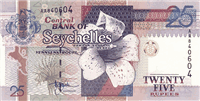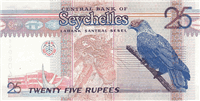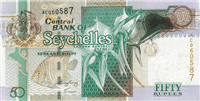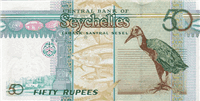Exchange Currency
Seychelles rupee
The rupee is the currency of the Seychelles. It is subdivided into 100 cents. In the local Seychellois Creole (Seselwa) language, it is called the roupi. The international currency code is SCR. The abbreviations SR and SRe are sometimes used.
The monetary system of Mauritius was used in the Seychelles until 1939. Banknotes were issued in Mauritius beginning in 1768, and coins for Mauritius were minted in France and French India. French Livres/Francs and Spanish Dollars also circulated in Mauritius, and thus the Seychelles, especially since the paper currency depreciated heavily during the Revolution. By 1800 the livre, nominally 10 per Spanish silver dollar (piastre), had depreciated to 10,000 paper livres = $1.
Indian Rupees and Spanish Dollars circulated in the Seychelles in the 1800s. The Currency Commissioners of Mauritius for Mauritius issued banknotes in 1848, and the Government of Mauritius began issuing banknotes in 1866; however, Mauritian banknotes probably had very little circulation in the Seychelles.
The Government of Seychelles began issuing emergency Rupee (SCR) banknotes in 1914, and began regular issues of banknotes in 1919. The Indian Rupee was the unit of account in the Seychelles until 1934, and the Mauritius Rupee was used as a medium of exchange until 1934 when the Seychelles Rupee became a separate currency linked directly to the British Pound Sterling. Coins were produced for the Seychelles in 1939. During the Second World War, problems with obtaining its own notes and coins by ship led Seychelles to make notes and coins of Ceylon, India, Mauritius, East Africa, and South Africa legal tender. After the war their legal tender status was withdrawn.
Banknotes were issued by the Government of Seychelles while it was a crown colony, by the Republic of Seychelles from 1976 until December 1, 1978, by the Seychelles Monetary Authority from December 1, 1978 until January 1, 1983, and by the Central Bank of Seychelles since 1983. The Rupee is divisible into 100 Cents.
Until 2008, the value of the Seychelles rupee was tied to a currency basket comprising 59 percent Euros, 31 percent British Pounds, and 10 percent U.S. Dollars. The currency was freely floated on November 2, 2008, promptly sinking 43% to 19.97 per euro on the first day of trading.
In 1939, coins in denominations of 10 and 25 cents, ½ and 1 rupee were introduced. The 10 cents was a new denomination minted in cupro-nickel with a scalloped shape, whilst the other three denominations were the same sizes as the Mauritian coins but were minted in a lower fineness of silver (.500). In 1948, bronze 1, 2 and 5 cents coins were introduced. The coins were the same size as the Mauritian coins and nearly identical in design.
In 1951, cupro-nickel replaced silver in the 25 cents. Further changes were made in 1953 and 1954, when a twelve-sided, nickel-brass 10 cents was introduced, replacing the scalloped cupro-nickel pieces. This was followed by cupro-nickel ½ and 1 rupee pieces. These were also the first Seychelles issues to begin depicting Queen Elizabeth II.
In 1972, round aluminium 1 cents and scalloped 5 cents were introduced (following the last issue of 2 cents in 1968) along with a seven sided cupro-nickel 5 rupees of identical size and weight to the British 50 Pence, and a large, round 10 rupees coin of the same composition. These also became the first coins in the country to depict flora and fauna rather than simple, classic designs. These coins continued to be in use in varying degrees until 1982.
In 1976, a short lived coin series was introduced celebrating the nation's newly independent status and featuring the first president of Seychelles, James Mancham. This series was discontinued just after the first year when James Mancham was deposed in a coup d'état by France Albert René. However, these coins continued to be circulated along with both earlier and later issues until 1982.
In 1977, the obverse on all coins was redesigned to feature the Coat of arms of Seychelles and the date was moved to the obverse from the reverse. Although well designed, this coin series was also relatively short lived.
In 1982 a new, downsized coinage was introduced, consisting of a redesigned brass 1, 5 and 10 cents that were all rounded rather than scalloped. The cupro-nickel 25 cents and, 1 and 5 rupees also saw changes, with a redesign of the 25 cents and a downsizing for the 1 and 5 rupees, the latter being changed from seven equilaterally curved sides to round. The 10 rupee piece was discontinued and withdrawn from circulation due to lack of demand in competing with the more popular notes.
Standard issue notes began to be issued in 1918, with notes for 50 cents and 1 rupee, followed by 5, 10 and 50 rupees in 1928. The 50 cents and 1 rupee notes were issued until 1951 and phased out in favor of the coins. 20 and 100 rupees notes were first introduced in 1968, whilst the 5 rupee note was replaced by a coin in 1972.
In 1976, the Seychelles Monetary Authority took over the issuance of paper money, issuing notes for 10, 25, 50 and 100 rupees. This series featured the first president of the Seychelles, James Mancham and replaced all colonial notes issued prior to independence.
In 1979, there was a redesign, featuring a more socialist and modernized theme reminiscent of the René Regime. This series was also issued by the Central Bank of Seychelles when it took over full responsibility in the same year.
In 1989, a new series was introduced with better security features and colors.
In 1998, another more high tech series was introduced with a more practical, ergonomic design. This series later saw an additional 500 rupees note first introduced in 2005.
Summary info
Summary information about Seychelles rupee- ISO 4217 Code:
- SCR
- Currency sign:
- SR or SRe
- Country:
- Seychelles
- Subunit:
- cent
- Coins:
- 1 cent, 5 cents, 10 cents, 25 cents, 1 rupee, 5 rupee
- Banknotes:
- 10 rupee, 25 rupee, 50 rupee, 100 rupee, 500 rupee
- Central bank:
- Central Bank of Seychelles
History
An expedition of the British East India Company made the first recorded landing on the Seychelles in 1609. The islands were uninhabited. France explored and later annexed the islands, in 1756. The British captured the islands in 1810, during the Napoleonic Wars, and retained it by the Treaty of Paris in 1814. The Seychelles were part of the colony of Mauritius. The Seychelles became a British crown colony on August 31, 1903 when the Seychelles broke from Mauritius. The Seychelles gained their independence as the Republic of the Seychelles on June 29, 1976.The monetary system of Mauritius was used in the Seychelles until 1939. Banknotes were issued in Mauritius beginning in 1768, and coins for Mauritius were minted in France and French India. French Livres/Francs and Spanish Dollars also circulated in Mauritius, and thus the Seychelles, especially since the paper currency depreciated heavily during the Revolution. By 1800 the livre, nominally 10 per Spanish silver dollar (piastre), had depreciated to 10,000 paper livres = $1.
Indian Rupees and Spanish Dollars circulated in the Seychelles in the 1800s. The Currency Commissioners of Mauritius for Mauritius issued banknotes in 1848, and the Government of Mauritius began issuing banknotes in 1866; however, Mauritian banknotes probably had very little circulation in the Seychelles.
The Government of Seychelles began issuing emergency Rupee (SCR) banknotes in 1914, and began regular issues of banknotes in 1919. The Indian Rupee was the unit of account in the Seychelles until 1934, and the Mauritius Rupee was used as a medium of exchange until 1934 when the Seychelles Rupee became a separate currency linked directly to the British Pound Sterling. Coins were produced for the Seychelles in 1939. During the Second World War, problems with obtaining its own notes and coins by ship led Seychelles to make notes and coins of Ceylon, India, Mauritius, East Africa, and South Africa legal tender. After the war their legal tender status was withdrawn.
Banknotes were issued by the Government of Seychelles while it was a crown colony, by the Republic of Seychelles from 1976 until December 1, 1978, by the Seychelles Monetary Authority from December 1, 1978 until January 1, 1983, and by the Central Bank of Seychelles since 1983. The Rupee is divisible into 100 Cents.
Until 2008, the value of the Seychelles rupee was tied to a currency basket comprising 59 percent Euros, 31 percent British Pounds, and 10 percent U.S. Dollars. The currency was freely floated on November 2, 2008, promptly sinking 43% to 19.97 per euro on the first day of trading.
Coins
Prior to 1939, Mauritius coinage circulated in the Seychelles, even though the islands had been politically autonomous of Mauritius since 1903 as a crown colony of Great Britain.In 1939, coins in denominations of 10 and 25 cents, ½ and 1 rupee were introduced. The 10 cents was a new denomination minted in cupro-nickel with a scalloped shape, whilst the other three denominations were the same sizes as the Mauritian coins but were minted in a lower fineness of silver (.500). In 1948, bronze 1, 2 and 5 cents coins were introduced. The coins were the same size as the Mauritian coins and nearly identical in design.
In 1951, cupro-nickel replaced silver in the 25 cents. Further changes were made in 1953 and 1954, when a twelve-sided, nickel-brass 10 cents was introduced, replacing the scalloped cupro-nickel pieces. This was followed by cupro-nickel ½ and 1 rupee pieces. These were also the first Seychelles issues to begin depicting Queen Elizabeth II.
In 1972, round aluminium 1 cents and scalloped 5 cents were introduced (following the last issue of 2 cents in 1968) along with a seven sided cupro-nickel 5 rupees of identical size and weight to the British 50 Pence, and a large, round 10 rupees coin of the same composition. These also became the first coins in the country to depict flora and fauna rather than simple, classic designs. These coins continued to be in use in varying degrees until 1982.
In 1976, a short lived coin series was introduced celebrating the nation's newly independent status and featuring the first president of Seychelles, James Mancham. This series was discontinued just after the first year when James Mancham was deposed in a coup d'état by France Albert René. However, these coins continued to be circulated along with both earlier and later issues until 1982.
In 1977, the obverse on all coins was redesigned to feature the Coat of arms of Seychelles and the date was moved to the obverse from the reverse. Although well designed, this coin series was also relatively short lived.
In 1982 a new, downsized coinage was introduced, consisting of a redesigned brass 1, 5 and 10 cents that were all rounded rather than scalloped. The cupro-nickel 25 cents and, 1 and 5 rupees also saw changes, with a redesign of the 25 cents and a downsizing for the 1 and 5 rupees, the latter being changed from seven equilaterally curved sides to round. The 10 rupee piece was discontinued and withdrawn from circulation due to lack of demand in competing with the more popular notes.
Banknotes
In 1914, the government produced emergency issues of notes for 50 cents, 1, 5 and 10 rupees.Standard issue notes began to be issued in 1918, with notes for 50 cents and 1 rupee, followed by 5, 10 and 50 rupees in 1928. The 50 cents and 1 rupee notes were issued until 1951 and phased out in favor of the coins. 20 and 100 rupees notes were first introduced in 1968, whilst the 5 rupee note was replaced by a coin in 1972.
In 1976, the Seychelles Monetary Authority took over the issuance of paper money, issuing notes for 10, 25, 50 and 100 rupees. This series featured the first president of the Seychelles, James Mancham and replaced all colonial notes issued prior to independence.
In 1979, there was a redesign, featuring a more socialist and modernized theme reminiscent of the René Regime. This series was also issued by the Central Bank of Seychelles when it took over full responsibility in the same year.
In 1989, a new series was introduced with better security features and colors.
In 1998, another more high tech series was introduced with a more practical, ergonomic design. This series later saw an additional 500 rupees note first introduced in 2005.
SCR banknotes pictures gallery
| 10 Seychelles rupee | |
|---|---|
| Banknote of 10 Seychelles rupee has dimensions 150×75 mm and main colors are manatee, cadet grey, wild blue yonder, pastel blue, platinum, pale spring bud, timberwolf and splashed white. The banknote of 10 Seychelles rupee was issued in 2010. | |
 Obverse side of the 10 Seychelles rupee is showing the Coco-de-mer palm. |
 Reverse side of the 10 Seychelles rupee is showing the Hawksbill turtle. |
| 25 Seychelles rupee | |
|---|---|
| Banknote of 25 Seychelles rupee has dimensions 150×75 mm and main colors are turkish rose, pale chestnut, pearl, old lavender, light slate gray, pale silver, timberwolf, white and pale silver. The banknote of 25 Seychelles rupee was issued in 2010. | |
 Obverse side of the 25 Seychelles rupee is showing the gardenia flower. |
 Reverse side of the 25 Seychelles rupee is showing the Blue Pigeon, Coconut Crab and Bi Centenary Monument. |
| 50 Seychelles rupee | |
|---|---|
| Banknote of 50 Seychelles rupee has dimensions 150×75 mm and main colors are pale silver, pastel gray, khaki, gray, pearl, isabelline, gainsboro and dark gray. The banknote of 50 Seychelles rupee was issued in 2011. | |
 Obverse side of the 50 Seychelles rupee is showing the Coat of arms, the map, the angelfish, paille en queue orchids, a turtle and swordfish. |
 Reverse side of the 50 Seychelles rupee is showing the cowrie shells, the cars, the clock tower in Victoria, an yellowfin tuna fish and the tiomitio bird. |
| 100 Seychelles rupee | |
|---|---|
| Banknote of 100 Seychelles rupee has dimensions 150×75 mm and main colors are candy pink, dark terra cotta, fuzzy wuzzy, pale carmine, wheat, pastel gray, timberwolf, desert sand and white smoke. The banknote of 100 Seychelles rupee was issued in 2011. | |
 Obverse side of the 100 Seychelles rupee is showing the pitcher plant and Vielle Babone Cecile. |
 Reverse side of the 100 Seychelles rupee is showing the large land tortoise and bridled tern. |
| 500 Seychelles rupee | |
|---|---|
| Banknote of 500 Seychelles rupee has dimensions 150×75 mm and main colors are umber, bole, auburn, raw umber, copper, tan, wheat, pearl, taupe and floral white. The banknote of 500 Seychelles rupee was issued in 2011. | |
 Obverse side of the 500 Seychelles rupee is showing the Coco-de-mer palm. |
 Reverse side of the 500 Seychelles rupee is showing the Central Bank of Seychelles building (Victoria), a man with fish and an owl. |
Useful links
- About Central Bank of Seychelles:
- Central Bank of Seychelles
- List of currencies:
- Currencies
- Security and design features of SCR banknotes:
- SCR banknotes
- SCR currency on Wikipedia:
- Seychelles rupee
- Official Website of Central Bank of Seychelles:
- www.cbs.sc
- Commemorative coins:
- Commemorative Coins